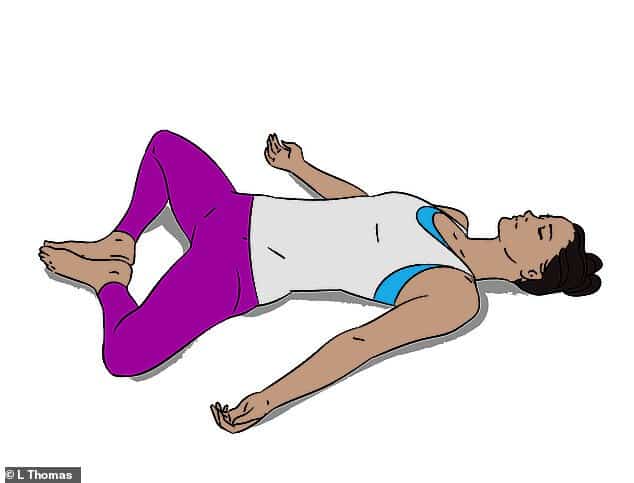Stressed? Just shake it off!: ANGELA NEUSTATTER puts 2019’s weirdest wellness trend to the test
Great article in the Daily Mail by Angela Neustatter on her session with TRE® Practitioner Steve Haines in London.
Welcome to the eyebrow-raising world of Tension and Trauma Releasing Exercises (TRE) — a way to literally shake off your worries that’s set to be one of the biggest wellness trends of 2019.
According to fans of TRE, the body stores memories of trauma — bereavement, financial worries, a stressful job or even just a bad experience at the dentist.
Steve Haines, the therapist leading my session at Triyoga in North London, explains how responses to trauma become buried as we battle to keep going. ‘We crunch ourselves up to avoid feeling pain. We resist letting go, preferring the stiff upper lip,’ he says.
‘Talking therapies certainly have their place, but they do not allow the body to use its natural mechanism to relieve stress involuntarily and powerfully.’
Steve believes mental healing should be balanced with a physical process. He takes me through simple TRE exercises designed to release deep muscular tension and tire muscles, which causes the body to shake.
The first involves standing up and rocking back and forth, rolling the ankles. Next comes a modified squat to work the thigh muscles, then a forward bend with legs apart, to stretch the hamstrings and groin.
This is followed by standing straight with your hands on the small of your back and your pelvis slightly forward to work the hip flexors. Most poses are held for a few minutes.

The exercises take up to 20 minutes. Steve suggests taking another 20 minutes for the shaking, which happens at a different pace for everyone. At the end comes ‘integration’ time, when you let your body completely relax on the floor.
Unlike in yoga, breathing is not a conscious effort. Steve says: ‘The breath may get a little faster, but that is all. This is not aerobic exercise.’
The idea is to tire the muscles enough so that they experience gentle tremors which reverberate up along the spine, releasing tension from the pelvis to the head.
These may start with a slight shimmer of movement, as they did with me, but they become more vigorous as the body recognises it can let go — provided we don’t use the mind to stop this happening.
It was meeting David Berceli, a psycho-neurologist who created TRE in 2010, that made Steve want to train in the method. When he saw what David, who works with trauma victims and war veterans with severe PTSD, was doing, he was convinced this offered an alternative healing approach.
When the brain perceives a threat, adrenaline and cortisol are released. David looked at how the body stores this in the fascia, the soft connective tissue just below the skin.
He worked on finding a treatment to counter the pain caused when the hormones put those suffering from trauma on high alert. He wanted to make the body use its natural reflexes to take control. This would mean trauma victims could learn to self-regulate when feelings threatened to engulf them.
‘We need to understand how, when negative feelings overwhelm us, the body gets a high chemical charge,’ says Steve. ‘The brain works to find a way to calm us again, but if we keep living with prolonged stress, we become so accustomed to the muscular tension that we don’t realise the harm it’s doing.’
Steve went on to be the first main TRE provider in the UK. To my relief, he is free of any guru tendencies, and claims to be ‘led by the science of TRE’. ‘Animals help themselves instinctively by shaking,’ he says, showing me videos, including a lion shaking after a fight, then sauntering away.
On my second day in the workshop, I am surrounded by people prone and quivering. Many have done yoga, Pilates and other bodywork over the years.
They include psychotherapists, teachers, community workers — people who deal with demanding situations.
One woman who experienced traumatic feelings in the wake of a kidney transplant, and was originally ‘a sceptic’, tried TRE and says she was ‘amazed something so simple could settle my psyche so effectively’.
Steve says TRE ‘doesn’t ask us to understand what is causing our pain, but shows us there is a nature-led way to switch off our fight-and-flight pattern’.
Giving your body the chance to shake three or four times a week for around 20 minutes is recommended, but it’s up to the individual to work out how long gives the best release for them.
If you can’t make it to a trainer, Steve recommends the Stress Less TRE app, with exercises to use at home.
Even so, he is not holding TRE up as a panacea. ‘Nothing works for everybody,’ he admits. ‘But what appeals to me is that it is a safe approach which teaches people to self-heal.’ It appeals to me, too. I enjoyed it more than I expected. It gave me a sense of being shaken out — in a good way. I bought the app afterwards, and have done the exercises a few times since.
I can’t say it has shifted deep-rooted trauma as, happily, I don’t think there was any, but the theory of it being able to release feelings we have suppressed seems
Source: Daily Mail

